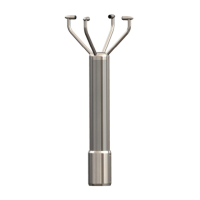
Do you have a question about the Gill Instruments Windobserver 65 and is the answer not in the manual?
| Brand | Gill Instruments |
|---|---|
| Model | Windobserver 65 |
| Category | Measuring Instruments |
| Language | English |
Lists all components included with the WindObserver 65 unit.
Details the specific part numbers for various WindObserver 65 configurations.
Specifies hardware and software needed for successful installation.
Provides guidance on connecting cables and assembling connectors.
General recommendations for installing the unit in various environments.
Procedure for testing unit functionality before final installation.
Details cable types, lengths, and termination requirements.
Specifies voltage and current requirements for the anemometer and heater.
Explains electrical connections, including earthing procedures.
Details the use of a specific interface for power and communication.
Instructions for connecting analogue voltage and current outputs.
How to interface the anemometer with the WindDisplay unit.
Guidance on physical mounting and location considerations.
Details available wind speed formats and various ASCII/binary data output types.
Configuration for connecting units in a network and communication parameters.
Settings for units, output frequency, and digital data averaging.
Configuration of additional parameters like Speed of Sound, Heating, and offsets.
Detailed explanation of ASCII, Binary, and NMEA data output structures.
Configuration and behavior of analogue output channels for voltage and current.
Overview of the WindView software functionality.
Steps to establish a connection between WindView and the anemometer.
How to use the WindSock display for wind speed and direction.
Steps for configuring and starting data logging within WindView.
Proper methods for cleaning and handling the anemometer to prevent damage.
Information on servicing, troubleshooting symptoms, and safe mode operation.
Explanation of status codes and procedures for performing bench tests.
Using ICC for calibration, zero wind checks, alignment, and unit return guidelines.
Definitions of technical terms and abbreviations used in the manual.
Information regarding the product guarantee and warranty conditions.
Explanation of how the ultrasonic anemometer measures wind.
EU Declaration of Conformity regarding EMC and RoHS standards.
